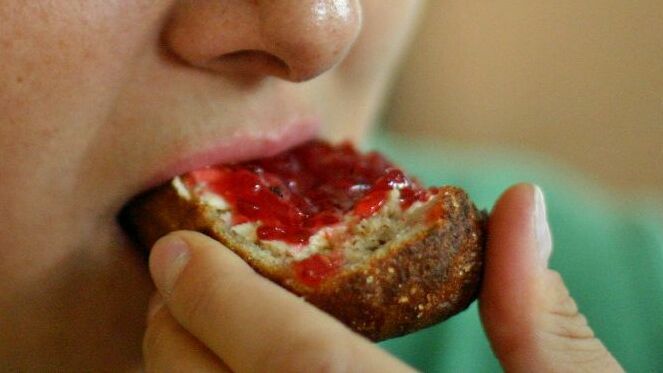One of the most frequent decisions we make is what to eat, but just because it’s a common task doesn’t mean it’s a simple one—at least when it comes to what happens in our brains. When making food choices, our brains integrate multiple sensory inputs to come to the conclusion of what we should eat, as well as how much of it to eat.
The food decision-making process begins before a single bite of food reaches our lips. After all, the first way we sense our food is through sight. Functional MRI (fMRI) scans have shown that looking at pictures of food activates multiple brain regions, most notably the orbitofrontal complex (OFC) [1] . This region, involved in decision-making, is also activated by the scent of food [2] . In the OFC, these visual and olfactory stimuli are integrated to provide a measure of the pleasantness and desirability of the food—the greater the perceived pleasantness of the food, the greater the OFC activation [2] .
The most important factor influencing the appeal of a food is, of course, how it tastes. fMRI scans of the human brain show that taste information is primarily processed in the anterior insula and frontal operculum, with secondary processing occurring in the OFC [2] Activations in the anterior insula and frontal operculum indicate both the identity and intensity of a taste [2] . In the OFC and anterior cingulate cortex, this information is integrated with visual, olfactory, and even textural information to produce a measure of the pleasantness of the food’s flavor [2] .
A food’s nutritive value also helps to determine its appeal, and the brain has ways of detecting nutrition independently of taste. Studies in mice and fruit flies have shown that both prefer sucrose (a nutritive sugar that contains calories [3] ) over sucralose (a nonnutritive, no-calorie sugar) even when their taste receptors were knocked out [4] . How could they tell the difference between the two? Their brains contain nutritive-sugar-activated neurons that release dopamine upon ingestion of sucrose [4] . While these results have yet to be replicated in humans, experiments have shown that the ingestion of different types of sugars does cause differences in human eating behavior [5] . So even if you’re not consciously thinking about the nutritional content of the food you’re eating, your brain is likely considering it.
Food desirability can further be modified by how it’s marketed. For example, human study subjects showed increased OFC activation when drinking an “expensive” wine than when drinking a “cheap” wine, or so they were told—the same wine was used for both treatments [6] . In a different study, increased activation of the OFC (and a related region, the pregenual cingulate cortex) was also detected when subjects were exposed to a flavor stimulus labeled “rich and delicious flavor,” versus when the same stimulus was labeled “boiled vegetable water.” [7] These examples show that how desirable a food is may depend on more than just the food’s appeal to the senses; cognitive factors also play a role.
Once you’ve decided what to eat, how do you know when you’ve had enough of it? One way the brain controls appetite is by decreasing OFC activation in response to a particular food after it’s eaten, reducing its desirability [2] . Overall satiation level is controlled through hormone signals secreted by gastrointestinal organs in the presence of foods, which travel to the brain to promote feelings of satiation [8] . Gut distension, or the expansion of the stomach, also triggers the release of these signals [9] . The control of appetite is truly a well-orchestrated collaboration between the gastrointestinal, endocrine, and nervous systems.
The next time you’re hankering for a snack and debating between, say, Swedish fish, roasted peanuts, or licorice, you probably won’t want to spend too much time mulling over the relative merits of each choice. Thankfully, your brain has you covered, so you can spend more time doing what’s really important—enjoying your food.
- Van der laan LN, De Ridder DT, Viergever MA, Smeets PA. The first taste is always with the eyes: a meta-analysis on the neural correlates of processing visual food cues. Neuroimage. 2011;55(1):296-303.
- Rolls ET. Taste, olfactory and food texture reward processing in the brain and the control of appetite. Proc Nutr Soc. 2012;71(4):488-501.
- Nutritive and Nonnutritive Sweetener Resources. (n.d.). Retrieved November 4, 2014, from http://fnic.nal.usda.gov/food-composition/nutritive-and-nonnutritive-sweetener-resources
- Yapici N, Zimmer M, Domingos AI. Cellular and molecular basis of decision-making. EMBO Rep. 2014;15(10):1023-1035.
- Ochoa M, Lallès JP, Malbert CH, Val-laillet D. Dietary sugars: their detection by the gut-brain axis and their peripheral and central effects in health and diseases. Eur J Nutr. 2014;
- Plassmann H, O’Doherty J, Shiv B, Rangel A. Marketing actions can modulate neural representations of experienced pleasantness. Proc Natl Acad Sci USA. 2008;105(3):1050-4.
- Grabenhorst F, Rolls ET, Bilderbeck A. How cognition modulates affective responses to taste and flavor: top-down influences on the orbitofrontal and pregenual cingulate cortices. Cereb Cortex. 2008;18(7):1549-59.
- Suzuki K, Simpson KA, Minnion JS, Shillito JC, Bloom SR. The role of gut hormones and the hypothalamus in appetite regulation. Endocr J. 2010;57(5):359-72.
- Wang GJ, Tomasi D, Backus W, et al. Gastric distention activates satiety circuitry in the human brain. Neuroimage. 2008;39(4):1824-31.
- Image by Torsten Mangner , licensed under public domain via Wikimedia Commons .
